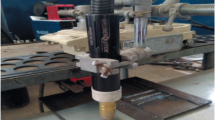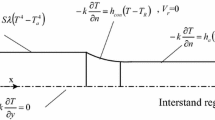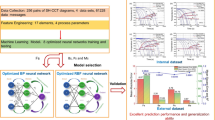Abstract
Oxide scales have significant influences on the surface qualities of hot-rolled steels. In the present work, an oxidation kinetic model for anisothermal conditions was employed with the aim of accurately controlling the evolution of scales during hot rolling, which could describe the evolution of scale thickness throughout hot rolling processes based on the scale growth behaviors at different stages, including reheating, rolling, and descaling. To improve the accuracy of the modeling, machine learning with the backpropagation artificial neural network (BPNN) and support vector machine (SVM) was used to calculate the values of oxidation rates and scale deformation ratios, and genetic algorithm (GA) was employed to optimize the model parameters. The modeling demonstrated high accuracy in predicting the evolution of scale thickness in hot rolling by comparing with the measured scale thicknesses. Based on the accurate predictions, the effects of steel compositions, rolling, and descaling processing parameters on scale growth behavior were analyzed, which presents the solution to working out the optimal processing windows for scale control.














Similar content being viewed by others
References
[1] R. Y. Chen and W. Y. D. Yuen: Oxid. Met., 2001, vol. 56, pp. 89-118.
[2] W. Sun, A. K. Tieu, Z. Jiang, H. Zhu, and C. Lu: J. Mater. Process. Technol., 2004, vol.155-156, pp. 1300-06.
[3] A. Chattopadhyay, N. Bandyopadhyay, A. K. Das, and M. K. Panigrahi: Scripta Mater., 2005, vol. 52, pp. 211-15.
[4] P. Wikstrom, W. Yang, and W. Blaslak: Steel Res. Int., 2008, vol. 10, pp. 765-75.
[5] J. H. Jang, D. E. Lee, M. Y. Kim, and H. G. Kim: Int. J. Heat Mass Transfer, 2010, vol. 53, pp. 4326-32.
M. Y. Kim: Int. J. Mech. Aerosp. Indus. Mechatron. Eng., 2013, vol. 7, pp. 1337–41.
[7] S. K. Dubey, and P. Srinivasan: Int. J. Therm. Sci.,2014, vol. 84, pp. 214-27.
[8] S. K. Dubey, and P. Srinivasan: J. Mech. Sci. Technol, 2014, vol. 28, pp. 1113-24.
[9] X. Liu, B. Worl, G. Tang, A. K. Silaen, J. Cox, K. Johnson, R. Bodnar, and C. Q Zhou: Steel Res. Int., 2019, vol. 90, pp. 1800385.
[10] M. Torres, R. Colás: J. Mater. Process. Technol., 2000, vol. 105, pp. 258-63.
[11] K. Schwerdtfeger, and S. X. Zhou: Steel Res. Int, 2003, vol. 74, pp. 538-46.
[12] S. X. Zhou, G. Liu, and Y. Cao: Steel Res. Int., 2006, vol. 77, pp. 336-41.
[13] S. X. Zhou: J. Mater. Process. Technol., 2003, vol. 134, pp. 338-51.
[14] L. Suárez, Y. Houbaert, X.V. Eynde, and R. Colás: Corros. Sci., 2009, vol. 51, pp. 309-15.
D. Filatov, O. Pawelski, and W. Rasp: Steel Res. Int., 2004, vol. 75, pp. 20-25.
[16] A. Rahnama, S. Clark, and S. Sridhar: Comput. Mater. Sci., 2018, vol. 154, pp. 169-77.
[17] A. Brahme, M. Winning, and D. Raabe: Comput. Mater. Sci., 2009, vol. 46, pp. 800-04.
[18] Y. Lv, J. Wang, J. Wang, C. Xiong, L. Zou, L. Li, and D. Li: Chaos, Solitons Fractals, 2020, vol. 136, pp. 109807.
[19] S. M. K. Hosseini, A. Z. Hanzaki, M. J. Y. Panah, S. Yue: Mat. Sci. Eng., 2004, vol. 374, pp. 122-28.
[20] O. Palavar, D. Özyürek, and A. Kalyon: Mater. Des., 2015, vol. 82, pp. 164-72.
[21] M. Younesi, M. E. Bahrololoom, and M. Ahmadzadeh: Comput. Mater. Sci., 2010, vol. 47: pp. 645-54.
[22] S. Guo, J. Yu, X. Liu, C. Wang, and Q. Jiang: Comput. Mater. Sci., 2019, vol. 160, pp. 95-104.
[23] C. Wagner: Z. Phys. Chem., 1933, vol. 21, pp. 25-41.
[24] Z. Liu, W. Gao: High Temp. Mater. Process., 1998, vol. 17, pp. 231-36.
[25] R. Y. Chen, W. Y. D. Yuen: Oxid. Met., 2003, vol. 59, pp. 433-68.
[26] G. I. S. D. Caplan, R. J. Hussey, and M. J. Graham: Oxid. Met., 1979, vol. 13, pp. 255-72.
[27] T. Fukagawa, H. Okada, Y. Maehara: ISIJ Int., 1994, vol. 34, pp. 906-11.
[28] Y. L. Yang, C. H. Yang, S. N. Lin, C. H. Chen, and W. T. Tsai: Mater. Chem. Phys., 2008, vol. 112, pp. 566-71.
X. Yuan, Y. Yao, and L. Chen: Acta Metall. Sin. (Engl. Lett.), 2014, vol. 27, pp. 401–06.
[30] C. W. Yang, J. H. Kim, R. E. Triambulo, Y. H. Kang, J. S. Lee, and J. W. Park, J. Alloys Compd., 2013, vol. 549, pp. 6-10.
[31] J. Ramírez-Cuellar, M. P. Guerrero-Mata, L.A. Leduc, and R. Colás: J. Phys. IV France, 2004, vol. 120, pp. 209-15.
[32] Y. Hidaka, T. Anraku, N. Otsuka: Oxid. Met., 2003, vol. 59, pp. 97-113.
[33] Y. Xu, X. Zhang, L. Fan, J. Li, X. Yu, X, Xiao, L. Jiang: Corros. Sci., 2015, vol. 100, pp. 311-21.
[34] S. Wu, J. Yang, G. Cao, Y. Qiu, G. Cheng, M. Yao, and J. Dong: IEEE Access, 2020, vol. 8, pp. 134124-36.
Acknowledgment
The authors would like to acknowledge the financial supports from the Ministry of Science and Technology, China (No. 2017YFB0305002), Liaoning Provincial Support for Innovation (XLYC 1902034), and the Fundamental Research Funds for Central Universities (N2124002-14).
Author information
Authors and Affiliations
Corresponding authors
Additional information
Publisher's Note
Springer Nature remains neutral with regard to jurisdictional claims in published maps and institutional affiliations.
Manuscript submitted February 6, 2021; accepted June 21, 2021.
Rights and permissions
About this article
Cite this article
Cui, C., Wang, H., Gao, X. et al. Machine Learning Model for Thickness Evolution of Oxide Scale During Hot Strip Rolling of Steels. Metall Mater Trans A 52, 4112–4124 (2021). https://doi.org/10.1007/s11661-021-06368-5
Received:
Accepted:
Published:
Issue Date:
DOI: https://doi.org/10.1007/s11661-021-06368-5




